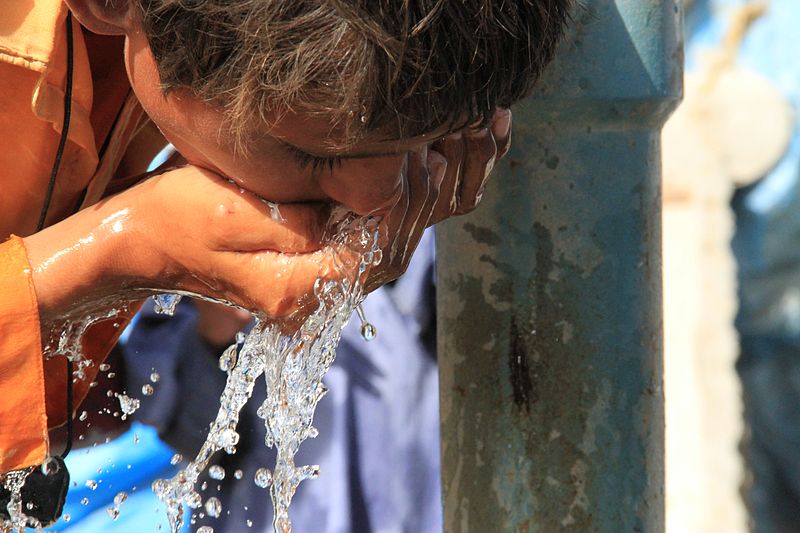World of nuclear and isotopic techniques to harness value of water
Groundwater is water found underground between spaces in soil, sand and rock, which is stored in and moves slowly through aquifers.

What does water mean to you? How much is it worth? This year’s World Water Day theme – valuing water – focuses on all of the different ways in which water benefits our lives: in health, hygiene, agriculture and even in culture. With increasing economic development and population growth, the world is getting thirstier for this vital resource. At the same time, climate change poses a challenge to water’s availability and quality.
With the help of the IAEA scientists around the world are diving into the world of nuclear and isotopic techniques to harness the value of water. By studying isotopes – variants of chemical elements – of water, scientists can reveal water’s origin, age, quality and use of water, and guide them on how to protect and preserve this fluid resource.
Managing groundwater
Groundwater is water found underground between spaces in soil, sand and rock, which is stored in and moves slowly through aquifers. According to the Global Water Partnership of Central America, in parts of Central America, groundwater is the primary water resource, due to the decline in quality and quantity of surface water resources, including freshwaters in rivers, lakes and reservoirs. This is largely due to El Niño - Southern Oscillation (ENSO), a periodic fluctuation of ocean surface temperature and air pressure that is linked to periodic droughts and flooding.
“ENSO events and subsequent water scarcity have resulted in food insecurity after suffering major crop losses in these areas,” said Lucia Ortega, IAEA Isotope Hydrologist. “The dependence on seasonal rainfall and groundwater recharge for agriculture, tourism, hydropower and a rapid demographic growth has further amplified the use of groundwater resources.”
The increased use of groundwater has highlighted the need to better understand factors affecting rainfall patterns and the links between groundwater recharge and discharge – the movement of water from surface water to groundwater and vice versa – to improve water management. Isotopic tools have been key in a new IAEA regional study to assess the interaction between rainfall inputs and the direction and magnitude of water flow above and below ground in Costa Rica, El Salvador, Honduras, Nicaragua and Panama.
Preliminary results of the study, published in 2020, can provide the information decision-makers need to protect and conserve critical recharge zones to ensure water security and sustainability.
In the Middle East and North Africa, many countries depend on groundwater resources, as well, due to the lack of surface water. “Many countries – especially those with the scarcity of freshwater resources – depend on groundwater as a source of drinking water and also for irrigation,” said Horst Monken-Fernandes, IAEA Environmental Remediation Specialist. In an ongoing project supported by the IAEA’s technical cooperation programme, isotope analysis and environmental remediation specialists helped experts in Jordan to measure and monitor the concentration of radium – a naturally occurring radioactive material (NORM) – in groundwater sampled from the Ram aquifer, and to explore options for the water’s treatment.
Natural processes, which are controlled primarily by the local geology and geochemistry, can lead to the contamination of groundwater by natural radionuclides, Monken-Fernandes explained. The project is supporting the construction and installation of a water treatment unit using hydrous manganese oxide to remove radium from water. Read more about the project. The IAEA is also supporting experts in Libya in groundwater management with respect to the enhanced concentration of natural radionuclides.
Managing water to adapt bananas to climate change
Isotopic techniques are also used to optimize the use of water in agriculture. The IAEA, in cooperation with the Food and Agriculture Organization of the United Nations (FAO), is assisting 50 countries in this area.
In East Africa, where one-fifth of the world’s bananas are produced, more frequent drought spells are threatening the fruit that serves as a food staple and source of income, according to the International Institute of Tropical Agriculture (IITA). “The changes in the distribution of rainfall and increasing frequency of dry spells, as a result of climate change, affect yields and quality of produce,” said Mathilde Vantyghem, Researcher at the Joint FAO/IAEA Centre of Nuclear Techniques in Food and Agriculture. While many studies focus on climate-smart practices for cereals, such as wheat, barley and rice, there is a lack of information for bananas, which “are important for small farmers, not only for income but also as food for millions of people.”
In 2019, the Joint FAO/IAEA Centre, with support from Belgium, launched the first comprehensive research and development programme to develop stable isotope techniques for adapting banana farming practices and evaluating banana varieties that are more drought-tolerant. In collaboration with the IITA and the Nelson Mandela African Institute of Science and Technology, researchers analysed how leaf samples can be collected for carbon-13 isotope analysis and what information can be gathered to make banana production more water-use efficient, which will contribute to the development of climate-smart banana cropping systems, Vantyghem said. Carbon-13 is used to measure and track how CO2 is being absorbed and released.
Join the webinar: Nuclear Techniques for Effective Water Management
The IAEA is hosting a webinar today at 15:00 Vienna time on water-related issues impacting people’s lives in different regions. IAEA Deputy Director General and Head of the Department of Nuclear Sciences and Applications, Najat Mokhtar, and experts from Costa Rica, Slovenia and Tunisia will discuss how isotopic tools are advancing water availability in Africa, improving groundwater resources management in Europe and optimizing water-use efficiency for producing crops, such as coffee, production in Latin America. The discussion will be followed by a question and answer session.










